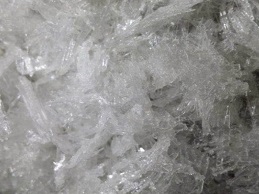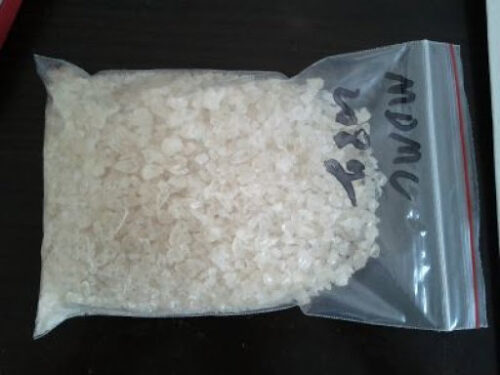
Drug
DescriptionPyrovalerone is a psychoactive drug with stimulant effects via acting as a norepinephrine-dopamine reuptake inhibitor, and is used for the clinical treatment of chronic fatigue or lethargy and as an anorectic or appetite suppressant for weight loss purposes.
Molar mass: 245.36 g/mol
ChemSpider ID: 13733
ChEMBL Id: 201960
PubChem CID: 14373
Formula: C16H23NO
People also search for: Methylenedioxypyrovalerone
Pyrovalerone(4-MPRC)
Price range: $180.00 through $670.00
Description
Description
Buy Pyrovalerone Online from Chemicals Pharm Store.
Buy Pyrovalerone Online (4-MPRC) Crystal Pyrovalerone(4-MPRC) Crystal (Centroton, 4-Methyl-β-keto-prolintane, Thymergix, O-2371) is a psychoactive drug with stimulant effects via acting as a norepinephrine-dopamine reuptake inhibitor (NDRI), and is used for the clinical treatment of chronic fatigue or lethargy and as an anorectic or appetite suppressant for weight loss purposes. It was developed in the late 1960s and has since been used in France and several other European countries, and although pyrovalerone is still occasionally prescribed, it is used infrequently due to problems with abuse and dependence. It is closely related on a structural level to a number of other stimulants, such as MDPV and prolintane (Promotil, Katovit).
Buy Pyrovalerone Online/Order GHB Wholesale/Retail Supplies Usage.
Best place to buy Pyrovalerone (Centroton, 4-Methyl-β-keto-prolintane, Thymergix, O-2371) is a psychoactive drug with stimulant effects via acting as a norepinephrine-dopamine reuptake inhibitor (NDRI), and is used for the clinical treatment of chronic fatigue or lethargy and as an anorectic or appetite suppressant for weight loss
High Quality Pyrovalerone Online History .
It’s stimulant and analog of Pyrovalerone & MDPV4-MPRC
Other names:4-Methyl-β-keto-prolintane, O-2371
IUPAC name: 1-(4-methyl-phenyl)-2-pyrrolidin-1-yl-pentan-1-one
CAS number: 1147-62-2
Formula: C16H23NO
Purity: 99,2% min
Appearance: white powder/white crystals
Pyrovalerone-cathinones: pyrovalerone and MDPV. They are very potent and selective catecholamine uptake inhibitors, but do not evoke the release of monoamines. A similar profile of action is characteristic for pentedrone and N,N-dimethylcathinone. Importantly, when compared to cocaine, MDPV is 50 times more potent at interacting with DAT and 10 times more potent with NAT (Baumann et al., 2013).
Some synthetic cathinones can additionally act as agonists or antagonists of different subtypes of 5-HT2 receptors (Simmler et al., 2013). Similarly, the 2C drugs bind to 5-HT2, and additionally to α-adrenergic receptors, and act as either agonist or antagonists, depending on the compound and the receptor type (Dean et al., 2013),
At the cellular level, mephedrone has been shown to increase Fos expression in the cortex, striatum, and ventral tegmental area of the rat brain, resembling the action of methamphetamine and MDMA, and in the supraoptic nucleus, which is characteristic of MDMA (Motbey, Hunt, Bowen, Artissm, & McGregor, 2012).
Studies on animals have revealed that BZP and cathinones, such as methylone, mephedrone, and MDPV, exert powerful locomotor stimulant effects in a dose- and compound-dependent manner (Gregg & Rawls, 2014; Monteiro et al., 2013). In a similar way to psychostimulant drugs of abuse, prolonged administration of BZP, mephedrone, and cathinone leads to the development of sensitization to their actions (Brennan, Johnstone, Fitzmaurice, Lea, & Schenk, 2007; Shortall et al., 2013). The results of behavioral experiments suggest that synthetic cathinones and BZP could have abuse and addiction potential in humans. Thus, it was found that MDPV, mephedrone, and methylone were self-administrated in rats; the same action was exerted by BZP in rhesus monkeys (Aarde, Angrish, et al., 2013, Aarde, Huang, Creehan, Dickerson, & Taffe, 2013; Fantegrossi, Winger, Woods, Woolverton, & Coop, 2005; Watterson, Watterson, & Olive, 2013). Mephedrone produced conditioned place preference in various species and lowered intracranial self-stimulation thresholds in mice (Gregg & Rawls, 2014). Another important observation indicating the abuse potential of BZP and cathinones is the capability of animals to discriminate them from saline and other substances. Interestingly, BZP possesses discriminative responses similar to that of amphetamine and MDMA (Fantegrossi et al., 2005; Yarosh, Katz, Coop, & Fantegrossi, 2007), discriminative effects of mephedrone are similar to MDMA, cocaine, and methamphetamine. MDPV discriminates from saline and fully substitutes for MDMA and methamphetamine, while methylone substitutes for methamphetamine (Gregg & Rawls, 2014).
There is little available information about pharmacokinetic properties of stimulant NPS. Metabolism of the 2C compounds involves O-demethylation at 2 and 5 positions, deamination, and oxidation either to the corresponding acid or base (Meyer & Maurer, 2010). Studies on metabolism of cathinone derivatives in rats and humans indicate that they undergo complex transformation: N-demethylation to the primary amine, reduction of the keto group to the hydroxyl group, and oxidation of the tolyl moiety to the corresponding alcohol and carboxylic acid (Meyer, Vollmar, Schwaninger, Wolf, & Maurer, 2012; Meyer, Wilhelm, Peters, & Maurer, 2010). Six phase I metabolites of mephedrone were detected in rat urine and seven in human urine (Meyer, Wilhelm, et al., 2010). Cytochrome P450 2D6 (CYP2D6) is the main enzyme responsible for the in vitro phase I metabolism of mephedrone and methylone (Pedersen, Petersen, & Linnet, 2013; Pedersen, Reitzel, Johansen, & Linnet, 2013); CYP2D6, CYP2C19, and COMT are involved in metabolism of MDPV (Meyer, Du, Schuster, & Maurer, 2010; Strano-Rossi, Cadwallader, de la Torre, & Botrè, 2010); CYP1A2, CY3A4, and CYP2D6 catalyze dealkylation and hydroxylation of BZP and TFMPP (Antia, Lee, Kydd, Tingle, & Russell, 2009; Antia, Tingle, & Russell, 2009). Phase I metabolites are eliminated with urine as glucuronide conjugates and sulfate conjugates. Demonstration of the important role of CYP2D6 in metabolism of cathinones and piperazines is of clinical importance. As CYP2D6 is involved in metabolism of numerous drugs and xenobiotics, pharmacokinetic interactions between psychostimulants and other compounds are likely to occur. Furthermore, the rate of metabolism and toxicity of NPS may depend on the genetic polymorphism of CYPP2D6. The effects of specific metabolites of stimulant NPS on the brain function need to be elucidated in order to better understand the complexity of their action.
Additional information
| Price | 100g, 50 mg, 500 mg |
|---|






